Plant guardians and the plants they look after often have a fascinating back story.
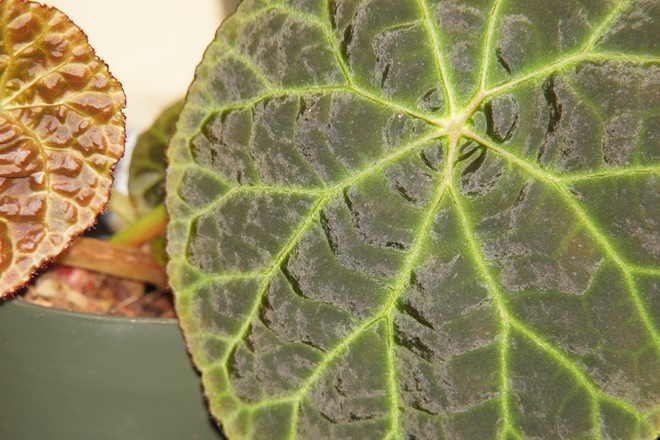
Begonia goegoensis
© T Jemmott
Begonia goegoensis
Introduced to the UK from Goegoe, Sumatra in 1881 by botanist Charles Curtis whilst in the employ of the renowned Veitch & Sons nursery to seek new plant species for their nursery business. The ‘Register of Garden Novelties, New Plants 1882’ (Moore T, Ed) subsequently records Veitch & Sons receiving a first class certificate from the RHS on July 25 1882 when it was unveiled as a new introduction.
Now rarely offered for sale, our Plant Guardian, Tim Jemmott says that "it is unusual for a begonia, being difficult to propagate vegetatively, with seed production being the best option. It resents being re-potted, but once you find somewhere it is happy, it is a very rewarding plant to grow with its variegated peltate leaves that glow red as the sun shines through them", a fitting description to describe a plant that is more commonly known as the fire-king begonia.
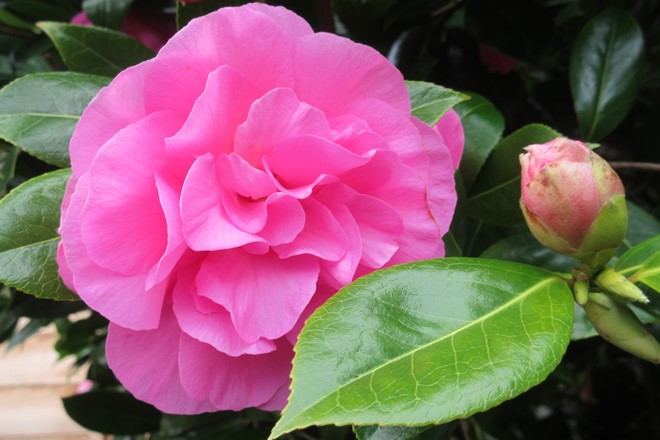
Camellia × williamsii 'Yesterday’
© Dr K Westbrook
Camellia × williamsii 'Yesterday’
Registered by one our Plant Guardians after being spurred on by an article in the Plant Heritage Spring Journal. Peter Westbrook says of his plant "On reading the article on Camellia Conservation in the Spring 2021 PH Journal I decided to investigate the large 35-year-old specimen growing in our garden, the name of which I had long forgotten. It had grown to a height of over 15 feet, reliably flowering every year in April and doing a grand job of screening a neighbouring garage. It needed little attention other than a yearly mulch of ericaceous compost, regular watering while the buds were forming for the following year and occasional height reduction to keep it in check. I was lucky to discover the original plant label which named the plant as Camellia x williamsii "Yesterday” and showed that it was purchased at Dobbies Garden Centre, Edinburgh, c1985, at a cost of £9.50p."
Peter’s registration of this wonderful plant has also highlighted the hybridisation work undertaken by Gillian Carlyon of Tregrehan Gardens. ‘Yesterday’, which first flowered in 1973 as a 20-year-old ‘seedling’, is one of over 33 camellias that originate from the breeding programme at Tregrehan.
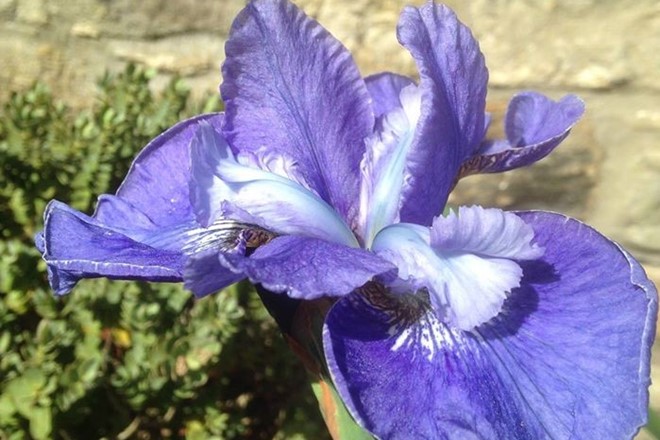
Iris 'Glanusk' (Sib)
© I Shaw
Iris ‘Glanusk’
First registered under the Plant Guardians scheme in 2016 and subsequently shared amongst our members through our wonderful Plant Exchange. Iris ‘Glanusk’ raised in 1990, is one of around 25 Siberian iris bred by Harry Foster of Crickhowell, Wales between 1986 and 1992. Described in The Siberian Iris Journal spring 1994 as being ‘immensely important in increasing the role of Siberian irises in the British Iris Society.’, he was renowned for ‘his great personal friendliness and charm.’
With no record of any current suppliers, this stunning plant is being conserved and shared through of our unique conservation and exchange schemes.
Our Plant Guardian, Isobel Shaw, says of ‘Glanusk’ that it “has so far been a good garden plant here on a rocky hillside in Northumberland, flowering I think every year since I was fortunate to take it on as PG plant. This is unusual in my garden as other varieties of iris fail to produce flowers at all. The flower is large for its type, the colour is intense and the marking rather striking.”

Dahlia 'Nellie Broomhead'
© J Forrest
Dahlia ‘Nellie Broomhead’
A pretty pompon dahlia with blooms ranging from almost white to rosy mauve. It was registered in 1897 by J.T. West, when it received the RHS Award of Merit. West originated or introduced around 400 dahlias from his nursery in Tower Hill, Brentwood, Essex.
Described in ‘Dahlias’ (1912) written by the then President of the National Dahlia Society, George Gordon, it was selected as one of ‘eighteen choice pompon dahlia for exhibition or garden decoration’ and was one of a few dahlias highlighted within the colour plate illustrations. It was regularly offered for sale in specialist dahlia catalogues until at least 1924.
Like another dahlia registered onto the Plant Guardians scheme, 'Little Beeswing', this pompon dahlia returned to UK shores via a small specialist nursery in Cambridgeshire, having sourced it from Scott Kunst’s Old House Gardens in the US, who, in turn, had received it from a Japanese collector of dahlias. It is wonderful to see this cultivar being shared amongst Plant Heritage members through our Plant Exchange as it currently has no listed suppliers within the UK.

Dahlia 'Little Beeswing'
Dahlia 'Little Beeswing'
This plant has taken us on a quite a journey and has demonstrated the value of the conservation work that Plant Heritage volunteers are quietly working on through the Plant Exchange and Plant Guardians schemes.
Originally bred by Keynes nursery of Salisbury in 1909, it was awarded an RHS Award of Merit later that year. However, as often happens, it fell out of favour over the following century and by the late 1990s was no longer available in nursery catalogues.
Luckily though, this lovely cultivar had made its way over the ocean and was in the hands of an American Dahlia enthusiast. It was prized over there for its drought tolerance, and when Scott Kunst in Michigan started to look for it, the last nursery to supply it handed him their entire stock as they were closing down.
From here it was repatriated to the UK and made available in a small, specialist nursery in Cambridgeshire. As this was the only supplier, 'Little Beeswing' became eligible for our Plant Exchange and Plant Guardian scheme, from where it has been making its way around the gardens of Plant Heritage members.
Because this bright Dahlia was flowering so beautifully in perfect time for the RHS Hampton Court Flower Show, and the plants given were of such lovely quality, it became a the star of the show in the Plant Guardian display.
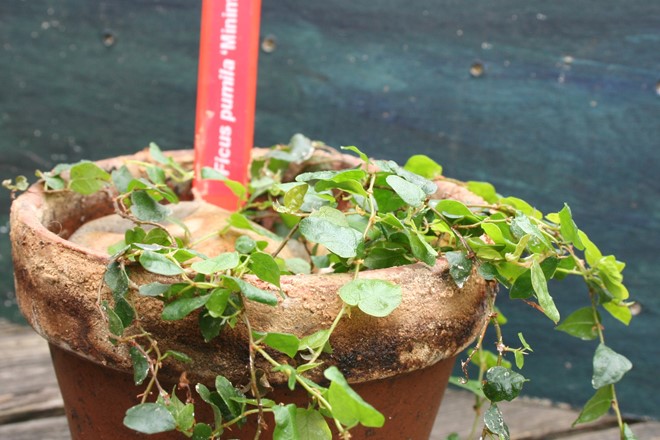
Ficus pumila 'Minima'
©Copyright Mike Squiers
Ficus pumila 'Minima'
Plants often pass through nurseries and gardens, promoted by experienced and respected plantsmen – loved for a while then are left behind. These are the plants both species and cultivars that we seek to find, protect and pass on through the Plant Guardian scheme.
One such plant appears to be Ficus pumila ‘Minima’ – but could it perhaps be a plant of new times with the resurgence in popularity for houseplants?
A small leaved, miniature type of the more common Ficus pumila, (the creeping or climbing fig), it was given to Edna Squires when she ran her nursery at Feebers, Devon by plantsman Bob Straughan from his specialist alpine nursery. A promise lightly given to look after this plant, with its heart shaped leaves, has never left Edna, who writes: ‘‘Whilst it is always good to have and propagate a plant that qualifies for guardianship there is always that 'what if it dies on me?' feeling".
The species, Ficus pumila stretches from eastern Asia to Vietnam, and since being introduced to eastern Australia, is has become common. However, this little cultivar ‘Minima’ appears very rarely. This delicate plant has reappeared exactly at the moment when many people are starting again to keep house plants and planting in terrariums, which would give this little plant the shady, frost free environment that it needs to scramble away. Perhaps F.p. ‘Minima’ is about to come into its own?
Pelargonium 'Pink Raspail'
This plant can be traced back to the 1920's at Pyrford Court, Surrey. When the house was sold in 2001, the conservatories were cleared and the plants destroyed, and it was no longer available commercially. However, cuttings had previously been given to a Plant Heritage member and it is now offered via the Plant Exchange. A plant was even sent to the grandson of the original owner of Pyrford Court - full circle and a plant saved.
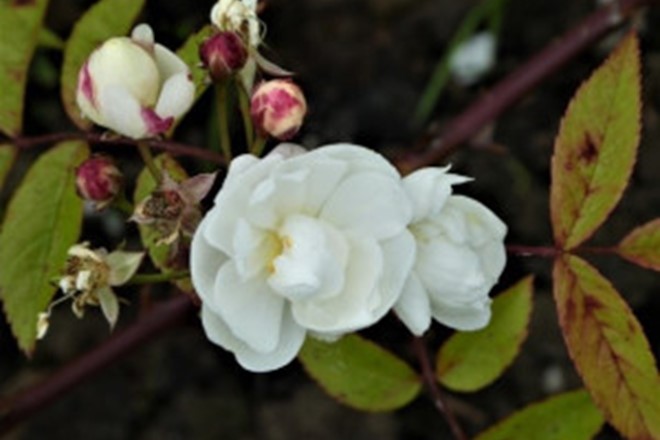
Rosa 'Lime Kiln'
© A. Penny
Rosa ‘Lime Kiln'
Out of the 2019 Plant Exchange in Sussex, came this story of a rose, now registered as a Plant Guardian plant.
Lime Kiln is the name of a house in Suffolk, owned from the late 1960’s by Humphrey Brooke. An art historian turned rose expert, he ultimately collected over 500 in his garden.
‘Lime Kiln’ is a rambler named by Brooke, which came into the hands of Catherine Penny, National Collection Holder of Pemberton Roses, via a fellow rose enthusiast.
Catherine says ‘it is distinct from most of the other giant white ramblers that I grow, because it has very red stems.’ When she sold her specialist rose nursery, any varieties which were unique to there immediately dropped out of commerce. This is a good illustration of how interesting cultivars become threatened and how our Plant Guardians scheme and the Plant Exchange can help to keep them in cultivation.
More rare plant stories can be found on our blog. You can also read more about some of our plant guardians in this series of articles on 'Garden Heroes', published in Garden News magazine.





